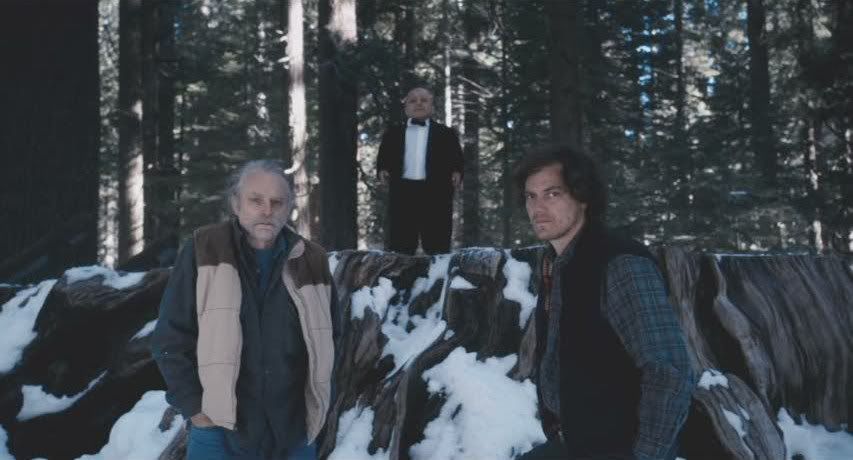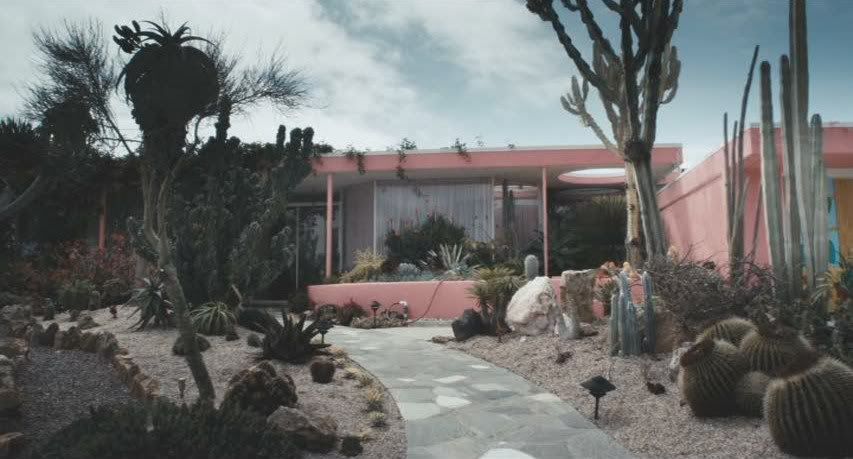
After nearly two decades in which Werner Herzog made very few fiction features, My Son, My Son, What Have Ye Done was one of two fictional films he released in 2009, along with his hallucinatory re-envisioning of Abel Ferrara's Bad Lieutenant. Like that film, My Son finds Herzog dabbling in genre, approaching the basic situations of the police thriller (a taut hostage standoff) and the horror film (a psychotic murderer unraveling before his family's eyes) and filtering them through his own off-kilter sensibility. The result is a film unlike any other in Herzog's career, a deeply strange and unsettling picture that reflects the madness of killer Brad McCullum (Michael Shannon) in the film's fragmentary structure and poetic evocation of disturbed mental states. This project was in gestation since the mid-90s, when Herzog seized on the real-life story of an insane man who'd killed his own mother, and this long-dormant script finally went into production following interest from David Lynch, who produced the film. Although Lynch was not a creative contributor to the project, something of his sensibility seems to have seeped into Herzog's system anyway, manifesting itself in an inclination towards surreal diversions and oddball, inexplicable interludes. But the film's central theme, that of a man succumbing to madness, is one that is dear to both Herzog and Lynch.
Brad is a vulnerable and somewhat damaged man to begin with, still living with his strange and sensitive mother (regular Lynch character actress Grace Zabriskie) while trying to maintain an increasingly strained relationship with his fiancée Ingrid (Chloë Sevigny). The film opens with Brad's ultimate deed of madness already done: he's killed his mother with a sword, then returned to his own home, where he holds off the police by claiming to have two hostages. The police show up, led by Detectives Havenhurst (Willem Dafoe) and Vargas (Michael Peña), but Herzog subverts the tension of the police hostage standoff by introducing an element of stasis and stagnation to the situation. Nothing seems to be happening: the detectives question Ingrid and Brad's friend, the theater director Lee (Udo Kier), probing into Brad's past through flashbacks, while nothing at all happens in the present. There is frequently a sense that Herzog is filming static tableaux, the cops not moving, standing behind their cars, pointing their guns unwaveringly at the blank façade of Brad's house. Several times, he inserts tracking shots that look up at the silent house from a low angle, capturing the absurdity of its pink-painted surfaces, the cacti planted on its dry lawn, the stillness of it all. At another point, Vargas glides through the frozen, posing cops, handing out water bottles, and he seems to be walking from one mannequin to the next. It's all so artificial, this stillness and stasis, this sense that everything is slowing down.

This inclination towards stasis and lack of motion reflects the obsessions of Brad himself, who is trying to find a frozen moment, what he calls a pivot point for the universe. While walking in the park with Ingrid, the people behind them seem to move in slow motion, jogging in place and throwing a frisbee that glides languidly through the air. Brad wants to find a "tunnel of time," and believes that he has discovered it when he walks down an up escalator, matching his pace to the speed of the escalator's ascent so that he remains frozen in space, walking but never moving, staring directly ahead into a tunnel formed by the futuristic architecture of the building, with Herzog's camera hovering behind his shoulder, staring with him into this void. Other tableaux cannot help but emphasize the aestheticized weirdness of this film, calling attention to Herzog's own hand.
The character of Brad's xenophobic, homophobic Uncle Ted (Herzog favorite Brad Dourif) is a perfect example. Ted tells Brad a story about wanting to film a midget riding the world's smallest horse, being chased by the world's smallest rooster around the world's biggest tree. He shows Brad photos of the tiny horse, while in the background a midget in a tuxedo wanders around; the three figures finally pause to stare at the camera for an unsettlingly long moment, completely shattering the sense of a forward-moving or linear narrative. The scene Ted describes, in fact, is one that Herzog had wanted to include in an earlier film, but had been unable to capture. He puts this story, one he's told many times over the years, into the mouth of this nasty character as a non-sequitur, an expression of weirdness for its own sake, a reminder of the man behind the camera, guiding all this insanity.

In fact, though My Son is ostensibly a story about going mad, it actually seems to be a story about a madness that never ends, that has always existed. Shannon's performance is not the performance of an ordinary man who loses his mind. He's depicting a guy who's somewhat off to begin with, living with a weird mother whose grief over the long-ago death of her husband continues to cast a shadow across her own life and the life of her son. Zabriskie's performance as Brad's mother relies on her ability to project creepy and mysterious emotions in every twitch of her expressive face, every slight quiver of her eyebrows, every nuance of her strained smiles. She is a possessive, hovering woman, as seen in flashbacks where she intrudes again and again on Brad and Ingrid in the privacy of his room, or where she buys Brad a piano and a drum kit, convinced for some reason that he wants these musical presents that he never plays. Under her disconcerting influence, Brad is weird to begin with, even before a trip to Peru where his friends all die while canoeing down a dangerous river. In that respect, Shannon's performance recalls the criticisms of Jack Nicholson's performance in The Shining, that the acting is so quirky and weird throughout that there's no convincing sense of a normal guy going mad. But that's missing the point, because here, as in The Shining, the madness is there all along: there's no going crazy, there's only crazy, or more accurately there's only life, which is crazy.
Indeed, Herzog is, as usual, filming a world that is inescapably, intrinsically mad. Thus the detours to Peru suggest that only Brad, out of all his friends, is attuned to the danger and ugliness of this beautiful place. Only he respects the wildness of nature, as expressed in a forceful speech where he rejects his friends' attempts to tame the exotic and the spiritual: he mocks their belief in herbal extracts and native rituals put on for the entertainment of tourists. This is a theme that obviously resonates with Herzog, whose films, some of them filmed along this same stretch of Peruvian river, are often all about the confrontations between man and terrifying nature. And it's fitting that only the man who's damaged and strange can understand just how weird nature is, can appreciate the odd beauty of the ostrich, a vicious bird despite its goofy appearance. And it's fitting too, in this film obsessed with birds, that Brad's "hostages" turn out to be his pet flamingos, to whom he gives Irish last names to match his own.

Obviously, there's more than a little dark humor in Herzog's apocalyptic vision, as he juxtaposes the grim fatalism of Greek tragedy with the flashy decor of the California suburbs. Brad, in killing his mother, is enacting a part he's played on stage, in a staging of Aeschylus's Eumenides, the story of Orestes killing his mother as vengeance for her murder of his father. The flashbacks to the rehearsals for this play mostly show Brad standing silently in the midst of the chorus as they weave around him, chanting lines that seem like prophecies given his later matricidal act. The director Lee recalls how good Brad was, but simultaneously talks about how he was constantly disrupting rehearsals, how things went great as long as Brad had no lines; more dark and subtle humor, delivered with understated wit by Kier. Even the relationship between Brad and Ingrid is darkly comical, mainly because one wonders why this woman would tolerate such creepiness for so long. There's a real disconnect in scene after scene where Brad or his mother does something outrageously creepy and unsettling, while Ingrid looks on with, at most, a bemused and resigned expression, suggesting that she's not quite right as well, that she fits too neatly into this twisted domestic drama. In a pointedly Freudian touch, Ingrid plays Brad's mother in Eumenides and, during her death scenes, he tells her to twitch her feet so he "can see his mother dancing to heaven," an echo of Nicholas Cage's insane cop in Herzog's Bad Lieutenant, hallucinating the break-dancing souls of dead mobsters.
In all these small touches — by turns disturbing, hilarious, ludicrous, and any combination of other extremes — Herzog continually tweaks and bends the basic situation of the hostage thriller. The genre skeleton of the film becomes like a tree trunk, off of which all sorts of bizarre branches wind off in unpredictable directions, tangling up with one another in the process. Herzog sometimes seems to be indulging all these oddball flourishes and non-sequitur interludes for no more reason than because he can. The film often seems weird simply for weirdness' sake, breaking the fourth wall to have the actors stare into the camera, or subtly nodding to producer Lynch in a scene where Brad encounters a piano that keeps playing when its player stands up and walks away, a probable ode to the infamous "Club Silencio" sequence of Mulholland Dr. The soundtrack, a mix of Ernst Reijseger's droning cello score with snippets of blues and Spanish folk music, similarly mashes together tones and styles, with Reijseger's horror soundtrack hum jarring against the intrusions of jaunty ethnic music. But even if the film often seems like a haphazard collage of weird moments and unsettling, unresolved plot threads, My Son, My Son, What Have Ye Done is never less than compelling, slowly worming its peculiar way into the viewer's mind, like a form of visual madness, a portrait of an unpredictable and loopy world where the usual rules don't apply.

5 comments:
Loved this review, Ed. Considered and thorough. And yes, weird that we should both post reviews of this at the same time... I really need to spend more time on here - you've got a heck of a lot of good readin' material here.
Garmonbozia!
Aha, that's a darn insightful section on stasis and motion, Ed. Excellent review.
I liked the film a lot. It's like Herzog's war on psychoanalysis. The joke's on us too. BL:POCNO and MYMYWHYD are two of the most rewarding Camp movies I've seen recently.
Cheers!
Thanks a lot, guys. I like the idea of this film as a "war on psychology," completely shattering the illusion that we can understand such bizarre behavior. Instead, everything is crazy and off-kilter, and, yes, very camp. It's great that Herzog has revitalized his fiction career in such an interesting way at this late stage.
Ed, this piece makes me want to revisit the film. When I first saw it, I was deeply underwhelmed; I was more or less uninterested in its ad-libbed weirdness. But reading these descriptions of some of the film's images bring back haunting memories. Though it didn't come together for, there were certainly scenes that made quite an impact. I especially agree with JAFB, who points out the superb mention of the film's propensity to slow down time.
Thanks, Carson. I'll be curious to know what you think if you do revisit it. I thought it was fascinating and unique, and well worth another look. If nothing else, it's wildly entertaining!
Post a Comment